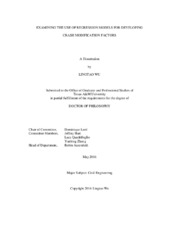| dc.description.abstract | Crash modification factors (CMFs) can be used to capture the safety effects of countermeasures and play significant roles in traffic safety management. The before-after study has been one of the most popular methods for developing CMFs. However, several drawbacks have limited its use for estimating high-quality CMFs. As an alternative, cross-sectional studies, specifically regression models, have been proposed and widely used for developing CMFs. However, the use of regression models for estimating CMFs has never been fully investigated. This study consequently sought to examine the conditions in which regression models could be used for such purpose.
CMFs for several variables and their dependence were assumed and used for generating random crash counts. CMFs were derived from regression models using the simulated data for various scenarios. The CMFs were then compared with the assumed true values. The findings of this study are summarized as follows: (1) The CMFs derived from regression models should be unbiased when the premise of cross-sectional studies were met (i.e., all segments were similar, proper functional forms, variables were independent, enough sample size, etc.). (2) Functional forms played important roles in developing reliable CMFs. When improper forms for some variables were used, the CMFs for these variables were biased, and the quality of CMFs for other variables could also be affected. Meanwhile, this might produce biased estimates for other parameters. In addition, variable correlation and distribution might potentially influence the CMFs and parameter estimates when improper functional forms were used. (3) Regression models did suffer from the omitted-variable bias. If some factors having minor safety effects were omitted, the accuracy of estimated CMFs might still be acceptable. However, if some factors already known to have significant effects on crash risk were omitted, the estimated CMFs were generally unreliable. (4) When the influence on safety of considered variables were not independent, the CMFs produced from the commonly used regression models were biased. The bias was significantly correlated with the degree of their dependence. | en |


